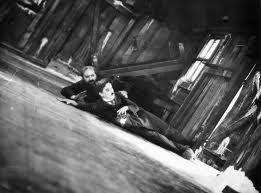The following is my entry in The World War One on Film Blogathon, being hosted at the blog Maddielovesherclassicfilms on Nov. 10 & 11, 2018. Click on the above banner to read bloggers’ tributes to movies depicting various aspects of the First World War!

For years, I’d heard about Wings, a silent feature film that was the first movie to win the Best Picture Oscar. For some reason, I imagined that it would seem as cliched as it sounded, perfect for its time but not aged well. Moral: Don’t listen to everything your subconscious tells you.
Wings is breathtaking and is one of the most beautifully composed movies I’ve ever seen. William Wellman was hired to direct it because at the time, he was the only director in Hollywood who had World War I combat pilot experience — and it shows in the movie’s details. This sprawling, 144-minute film has every kind of shot you can imagine — conventional, specially framed, documentary-style war footage — and there isn’t a wasted shot in the movie. Every frame is there to either push the narrative forward or make you stay bolted upright in your seat to see what happens next.
The movie’s main storyline is a bit more predictable than the eye-popping aerial footage, but even this part of the movie is put forth effectively. Neighborhood boys Jack Powell and David Armstrong (Charles “Buddy” Rogers and Richard Arlen) have two things in common: they both want to become airplane pilots, and both of them vie for the same neighborhood girl, Sylvia (Jobyna Ralston). Meanwhile, frisky Mary (Clara Bow) flits around David like a cute hummingbird and can’t figure out why Jack can’t see she’s madly in love with him — the stupid man!
The movie’s original story was rewritten to play up Clara Bow, who was America’s “It” Girl at the time. This is the first time I’ve ever seen a Clara Bow movie — sorry, folks, I’m not the hardcore silent-film buff I pretend to be — and it’s easy to see how and why she won moviegoers over. She radiates joy and happiness throughout this macho-based scenario, and you quickly get the feeling that if she can’t win Jack over, he doesn’t deserve her.
Kudos also go to Rogers and Arlen as the military rivals who can’t seem to make up their minds whether they should like or despise each other. Even the supporting actors add weight to the story. In an early but memorable role, Gary Cooper displays the charisma that gained him fame in the movies. And comic relief El Brendel takes a hoary stereotype — the silly Dutchman — and imbues him with character and charm.
As expected, the sweeping aerial footage is mesmerizing, shot from so many different angles that it looks as though it would take a general to make sense of it — but as Hollywood noted, Wellman certainly was the man for the job. And even though you can see the climax of the love-triangle subplot coming a mile away, it turns out to have an almost Shakespearean inevitability about it.
The best silent movies still hold up after numerous decades of viewing, and Wings certainly makes the grade.















